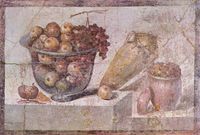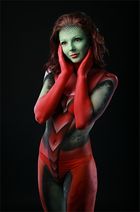Trompe-l'œil
Trompe-l'œil, which can also be spelled without the hyphen in English as trompe l'oeil,[1] (French for 'deceive the eye', pronounced [tʁɔ̃p lœj]) is an art technique involving extremely realistic imagery in order to create the optical illusion that the depicted objects appear in three dimensions.
Contents |
History in painting


Although the phrase has its origin in the Baroque period, when it refers to perspectival illusionism, use of trompe-l'œil dates back much further. It was (and is) often employed in murals. Instances from Greek and Roman times are known, for instance in Pompeii. A typical trompe-l'œil mural might depict a window, door, or hallway, intended to suggest a larger room.
A version of an oft-told ancient Greek story concerns a contest between two renowned painters. Zeuxis (born around 464 BC) produced a still life painting so convincing, that birds flew down from the sky to peck at the painted grapes. He then asked his rival, Parrhasius, to pull back a pair of very tattered curtains in order to judge the painting behind them. Parrhasius won the contest, as his painting was of the curtains themselves.
With the superior understanding of perspective drawing achieved in the Renaissance, Italian painters of the late Quattrocento such as Andrea Mantegna (1431 - 1506) and Melozzo da Forlì (1438 - 1494), began painting illusionistic ceiling paintings, generally in fresco, that employed perspective and techniques such as foreshortening in order to give the impression of greater space to the viewer below. This type of trompe l'œil illusionism as specifically applied to ceiling paintings is known as di sotto in sù, meaning from below, upward in Italian. The elements above the viewer are rendered as if viewed from true vanishing point perspective. Well-known examples are the Camera degli Sposi in Mantua and Antonio da Correggio's (1489 –1534) Assumption of the Virgin in the Duomo of Parma. Similarly, Vittorio Carpaccio (1460 – 1525) and Jacopo de' Barbari (c.1440–before 1516) added small trompe-l'œil features to their paintings, playfully exploring the boundary between image and reality. For example, a fly might appear to be sitting on the painting's frame, or a curtain might appear to partly conceal the painting, a piece of paper might appear to be attached to a board, or a person might appear to be climbing out of the painting altogether—all in reference to the contest of Zeuxis and Parrhasius. In a 1964 seminar, the psychoanalyst and theorist Jacques Lacan (1901 –1981) observed that the myth of the two painters reveals an interesting aspect of human cognition. While animals are attracted to superficial appearances, humans are enticed by the idea of that which is hidden.
Perspective theories in the 17th-century allowed a more fully integrated approach to architectural illusion, which when used by painters to "open up" the space of a wall or ceiling is known as quadratura. Examples include Pietro da Cortona's Allegory of Divine Providence in the Palazzo Barberini and Andrea Pozzo's Apotheosis of St Ignatius [4] on the ceiling of the Roman church of Sant'Ignazio.
The mannerist and Baroque style interiors of Jesuit churches in the 16th and 17th-century often included such trompe-l'œil ceiling paintings, which optically 'open' the ceiling or dome to the heavens with a depiction of Jesus', Mary's, or a saint's ascension or assumption. An example of a perfect architectural trompe-l'œil is the illusionistic dome in the Jesuit church, Vienna, by Andrea Pozzo , which is only slightly curved but gives the impression of true architecture.
A fanciful form of architectural Trompe-l'œil is known as quodlibet which features realistically rendered paintings of such items as paper-knives, playing-cards, ribbons and scissors, apparently accidentally left lying around, painted on walls.[2]

Trompe-l'œil can also be found painted on tables and other items of furniture, on which, for example, a deck of playing cards might appear to be sitting on the table. A particularly impressive example can be seen at Chatsworth House in Derbyshire, where one of the internal doors appears to have a violin and bow suspended from it, in a trompe l'œil painted around 1723 by Jan van der Vaart [1]. The American 19th century still-life painter William Harnett specialized in trompe-l'œil. In the 20th century, from the 1960s on, the American Richard Haas and many others painted large trompe-l'œil murals on the sides of city buildings, and from beginning of the 1980s when German Artist Rainer Maria Latzke began to combine classical fresco art with contemporary content trompe-l'œil became increasingly popular for interior murals.
In other artforms
.jpg)
Trompe-l'œil has long been used in set design, so as to create the illusion of a much deeper space then the actual stage. A famous early example is the Teatro Olimpico in Vicenza, with Vincenzo Scamozzi's seven forced-perspective "streets" (1585) which appear to recede into the distance.
Trompe-l'œil is employed in Donald O'Connor's famous "Running up the wall" scene in the film Singin' in the Rain (1954). During the finale of his "Make 'em Laugh" number he first runs up a real wall. Then he runs towards what appears to be a hallway, but when he runs up this as well we realize that it is a large trompe-l'œil mural. More recently, Roy Andersson has made use of similar techniques in his feature films.
Another variant of trompe-l'œil is matte painting, a technique used in filmmaking where parts of a complicated scenery are painted on glass panels which are mounted in front of the camera during shooting of the scene. This was for instance used in early Star Wars movies.
Fictional trompe-l'œil is featured in many Looney Tunes, such as the Road Runner cartoons, where, for example, Wile E. Coyote paints a tunnel on a rock wall, and the Road runner then races through the fake tunnel. This is usually followed by the coyote's foolishly trying to run through the tunnel after the road runner, only to smash into the hard rock-face. This sight gag was employed in Who Framed Roger Rabbit.

On Chicago’s Near North Side, a 16-story 1929 apartment hotel converted into a 1981 apartment building, was used by Richard Haas for trompe-l'œil murals in homage to Chicago School architecture. One of the building's sides features the Chicago Board of Trade Building, intended as a reflection of the actual building two miles south. [3][4]
Trompe l´oeil, also known as illusion painting, is also used in contemporary interior design, where illusionary wall paintings experienced a Renaissance since around 1980. Significant artists in this field are the German muralist Rainer Maria Latzke, who invented in the 90's a new method of producing illusion paintings, the Frescography and the English artist Graham Rust.
Today, Joanne Gair is a leader of this genre as a body painting specialist. Her paintings were featured for the tenth consecutive year in the 2008 Sports Illustrated Swimsuit Issue. She gained iconic status with the Demi's Birthday Suit Vanity Fair cover of Demi Moore in 1992, and is possibly even more famous for her Disappearing Model in 2000,[5] which was part of the highest rated episode of Ripley's Believe It or Not! to air on TBS. Washington, D.C. based artist Alexa Meade has also gained recent fame for her "Reverse Trompe-L'oeil" art, in which "creates optical illusion based installations and photographs in the trompe l'oeil style" from painting the human body to look like 2D oil paintings.[6] Journalist Dan Zak likened Meade's work to to the art of Joanne Gair, but "there's something different about Meade's project that strikes some gallerists and artists as novel and new."[7]
Trivia
George Washington was once fooled by a trompe-l'œil painting when he visited the studio of Charles Willson Peale. Upon entering a room containing on its far wall such a painting of someone descending a stair (apparently into the room), he is said to have bowed to the figure before he realized it was a painting. The painting, Staircase Group showed two of Peale's sons.
Examples of trompe-l'œil paintings
 Portrait of a Carthusian by Petrus Christus (1446). Note the fly near the bottom. |
 Jacopo de' Barbari, 1504. The first still-life trompe l'oeil since antiquity |
 Painter with a Pipe and Book by Gerard Dou (c.1654) |
 Trompe l'œil by Henry Fuseli (1750) |
 The "sculpture" is a flat cutout |
 A painting of papers and tools held by straps |
 A trompe l'oeil black board. |
Trompe l'œil in Jackie Kennedy dressing room by Pierre-Marie Rudelle (1970) |
Examples of trompe-l'œil murals
 Painted dome at Church of St Ignatius, Rome |
 Complete anamorphosis of the frontage of the Saint-Georges Theatre |
 Oculus on the ceiling of the Spouses Chamber, castle of San Giorgio in Mantua, Italy, by Andrea Mantegna |
|
 A trompe-l'œil of a pigeon on a window sill, façade mural, rue Emile Lepeu in Paris, France |
 Mural in Schwetzingen, Germany (the view "through" the wall at the end) |
 Architectural trompe-l'œil in the Palazzo Spada, Rome, by Francesco Borromini |
|
 Trompe-l'œil mural Tunnelvision by Blue Sky located in Columbia, South Carolina |
 Bronze Statues trompe-l'œil in Mt. Pleasant, Utah |
||
 Architectural wall and ceiling trompe-l'œil, Entrance to the library of Chateau Thal, by Rainer Maria Latzke |
Examples of trompe-l'œil sculptures
 19th century marble bust with apparently transparent veil, Bankfield Museum |
 The effect is consistent from all angles and from close up. |
 A modern Trompe-l'œil mosaic |
Trompe-l'œil artists
Old Masters
- Masaccio
- Luca Giordano
- Cornelis Norbertus Gysbrechts
- Charles Willson Peale
- Andrea Pozzo
- Vincenzo Scamozzi
- Giovanni Battista Tiepolo
19th century and modern masters
- Henry Alexander
- Aaron Bohrod
- Salvador Dalí
- Walter Goodman
- John Haberle
- William Harnett
- René Magritte
- John F. Peto
Contemporary
- Ellen Altfest
- Julian Beever
- Daniela Benedini
- Henri Cadiou
- Ronald Francis
- Richard Haas
- Rainer Maria Latzke
- István Orosz (Utisz)
- Os Gêmeos, "The Twins"
- Jacques Poirier
- Susan Powers
- John Pugh
- Pierre-Marie Rudelle
- Graham Rust
- Anthony Waichulis
- Sara Watson
- Kurt Wenner
- Asha Zero
Usage in films
- Eternal Sunshine of the Spotless Mind
- Indiana Jones and the Last Crusade
- Willy Wonka & the Chocolate Factory (1971)
- Where the Heart Is (1990)
Video games
- Pilotwings
- Super Mario 64
See also
- 2.5D
- Marbling
- Faux Painting
- Photorealism
- Anamorphosis
- Optical illusion
- Ubiquitous gaze
- Still life painting
Notes
- ↑ For example by the National Gallery of Art, Washington
- ↑ Curl, James Stevens (Paperback). A Dictionary of Architecture and Landscape Architecture (Second ed.). Oxford University Press. pp. 880 pages. ISBN 0198606788.
- ↑ "The City as Artifact". Chicago Historical Society. http://www.encyclopedia.chicagohistory.org/pages/288.html. Retrieved 2007-08-05.
- ↑ "Mural, Homage to the Chicago School, by Richard Haas, 1980". Chicago Historical Society. http://www.encyclopedia.chicagohistory.org/pages/3766.html. Retrieved 2007-08-05.
- ↑ Los Angeles Times syndication carried in numerous publication such as Reynolds, Susan Salter (2002-10-24). "With Twirl of Her Brushc, Artist Turns Human Body Into Canvas". Miami Herald. http://docs.newsbank.com/openurl?ctx_ver=z39.88-2004&rft_id=info:sid/iw.newsbank.com:NewsBank:MIHB&rft_val_format=info:ofi/fmt:kev:mtx:ctx&rft_dat=0F6E421D5901E9BA&svc_dat=InfoWeb:aggregated5&req_dat=0D0CB579A3BDA420. Retrieved 2009-04-23. and Reynolds, Susan Salter (2002-11-03). "There's no art experience quite like painting upon a human canvas". San Francisco Chronicle. http://www.sfgate.com/cgi-bin/article.cgi?f=/c/a/2002/11/03/LV26166.DTL&hw=Joanne+Gair&sn=001&sc=1000. Retrieved 2009-04-23.
- ↑ http://www.hifructose.com/the-blog/543-the-trompe-loeil-of-alexa-meade.html
- ↑ http://www.washingtonpost.com/wp-dyn/content/article/2010/03/23/AR2010032303850_2.html
External links
- Trompe-l'Oeil museum in France
- International Trompe l'Oeil Festival of Lodi - Italy
- Deceptions and Illusions, National Gallery of Art exhibition on Trompe-l'œil paintings
- Trompe l'œil Tricks: Borges' Baroque Illusionism, essay by Lois Parkinson Zamora comparing trompe-l'œil to the literature of Borges
- murals.trompe-l-oeil.info, More than 10 000 pictures and 1200 Outdoor murals of France and Europe
- Fooling the eye Fooling The Eye: A history of trompe l'oeil.
- Paris trompe-l'oeil, avenue George V. Text and photos by Catherine-Alice Palagret
- Painted Ladies, Canada's largest surviving concentration of this art style
- Suzanne Lilar's theory of the trompe-loeil, Pt. 1 video clip
- Suzanne Lilar's theory of the trompe-loeil, Pt. 2 video clip





